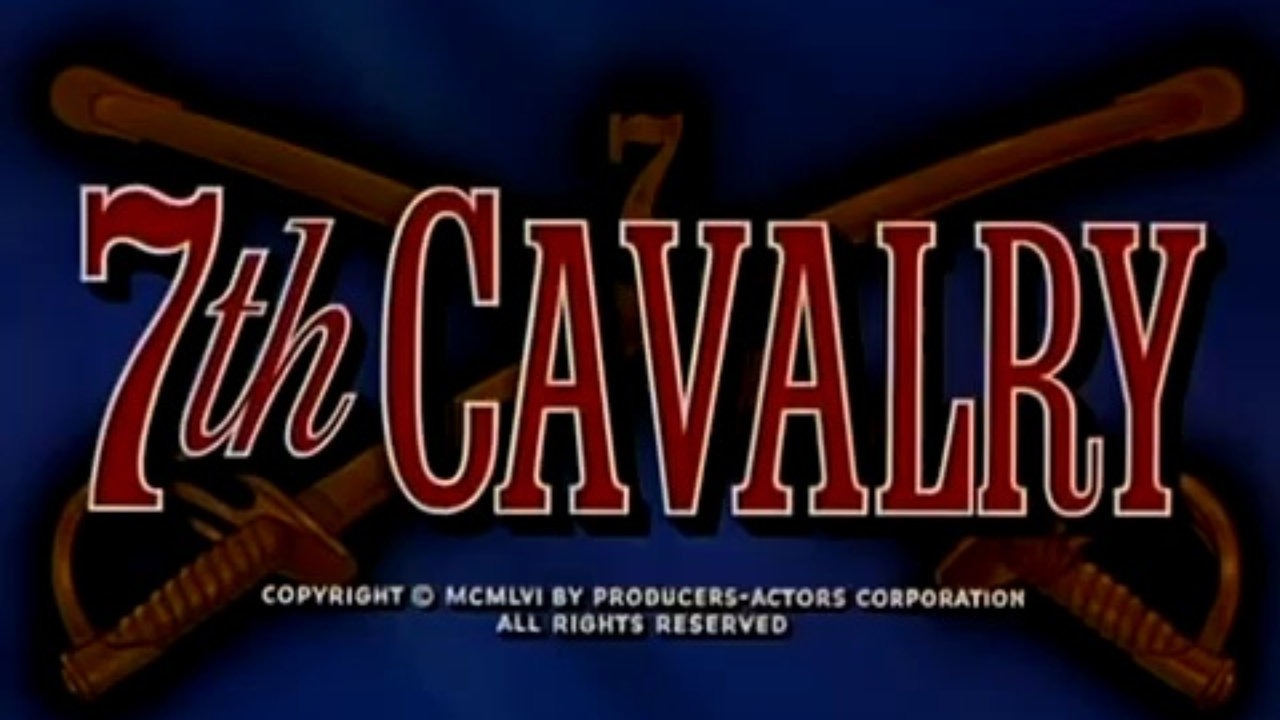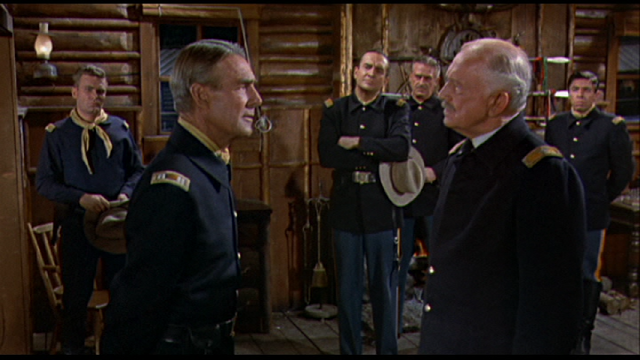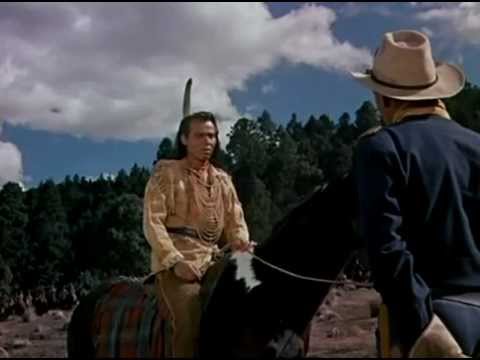The ‘7th Cavalry’ (1956) is about the aftermath of the Battle of Little Big Horn in June of 1876 when many plains indians united in the Great Sioux War. George Custer led his seven hundred troops into a trap of which he was warned by scouts and against the objections of subordinates. Though dead when this story starts, Custer’s pall lies over it all. He is lionised as a great leader, soldier, general, man, and paragon down to his yellow hair. On him more at the end.
 Lobby poster.
Lobby poster.
The story is a combination court room drama, star crossed lovers (for once Scott gets the girl), dissension in the ranks, and a culture clash.
The tension arises because Scott was sent on leave by Custer just before he set out for the valley of the Big Horn River. It was verbal order and in a subsequent inquiry the suspicion arises that Scott had deserted and is lying about the order. (How anyone could believe for a nanosecond that Scott would do something so dastardly beggars belief.) The result of the inquiry is inconclusive.
Then comes an order from distant Washington D.C. to retrieve the bodies of the now honoured dead. Gulp! The war is on and that is a battlefield. There are seven hundred dead, only a few hundred remain in the fort, demoralised, frightened, and confused without the great Custer.
Who will do it?
 I’ll go.
I’ll go.
Scott steps forward. (Of course.) He’ll go where the others fear to tread. With a detail of a few misfits not otherwise needed by the garrison, off he goes, tall in the saddle as always. The misfits include J. C. Flippen, Frank Faylen, and Denver Pyle. Familiar faces all. How this handful of misfits is going to bury hundreds and cart home the remains of the officers is anyone’s guess.
There are many vistas of the Alabama Hills where it was filmed, and much dissension in the ranks, which Scott deals with – wallop. Denver Pyle is ever reliable as a malingering whiner.
The high point of the picture is the negotiation at the Big Horn with the Sioux, who are forbearing, dignified, and conscientious.
 The negotiation.
The negotiation.
The Sioux belief that the spirit of slain enemies nourishes their strength means the dead must remain in situ, especially Yellow Hair, the leader. Hearing this explanation from a Christian mission-reared Sioux, Scott says, ‘but you know that is all superstition’ to which the Sioux replies ‘just like your Christianity.’ Scott offers no reply. Superb. A moral and intellectual standoff between two well-meaning individuals who are now on a collision course.
Spoiler alert! Though guns are drawn and arrows slung, an ominous silence reigns. What Hollywood director would dare do that today? Sitting Bull and Crazy Horse have no wish to desecrate the field, but neither will they relinquish the bodies.
For the denouement have a look on Daily Motion.
It is a loose end that the messenger whose testimony finally and fully exonerates Scott does not seem ever to have delivered this testimony, and is killed without a comment. It was Harry Carey Jr.
George Custer had a great press, partly because of the efforts of wife and widow. He was careless with the lives of his men throughout his career, though of course he took the same risks himself, if that is any consolation. In the spring of 1865 when the ghost Army of Northern Virginia manoeuvred out of the deathtrap of its trenches at Petersburg, Custer ordered his cavalry division into a frontal attack on a scant division of emaciated infantry under Richard Anderson’s command.
Think about it. Men on horseback at a distance of several miles array in a line and then gallop over water courses of a wet spring and scrub bush toward a line of infantry men who, seeing them far off, had enough time to build defensive breastworks of fencing and wagons, unlimber and aim artillery, and to lock and load, take aim, and fire, long, long before the horsemen get close. An infantry musket had a killing range of five hundred yards. In the hands of a marksman the range was as much a 1,200 yards.
The feeble grey infantry killed a great many mounted bluecoats and broke the attack. It was madness. Custer’s command had the latest repeating rifles but even if an trained horseman could handle the weapon while galloping, the chance of hitting anything were near zero and reloading once the first seven shots were fired was impossible at a gallop.
The advantage of numbers saved the day, and the headlines, for Custer. His vastly larger force withdrew and flanked the Confederate line and compelled a withdrawal. How much better it would have been for the widows and orphans of the men in his command if the flanking move had preceded, and thereby obviated, the frontal attack. There was no Tennyson to immortalise this catastrophe. Yet the Custer publicity machine turned it into a great victory for him at Little Sailor’s Creek.
Skip to content
